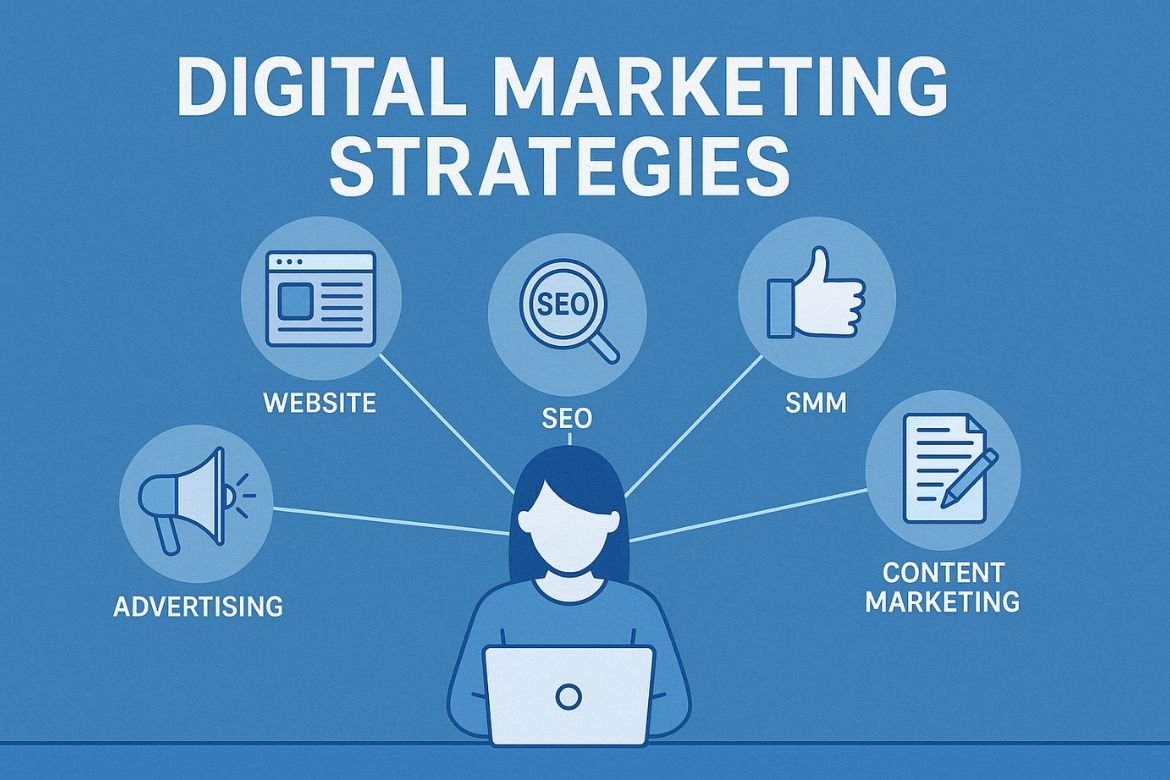Key Takeaways
- Comprehensive Digital Strategies: Utilize diverse methods like content marketing, SEO, social media, and paid ads to connect with your audience and drive growth.
- Audience Understanding is Key: Knowing your target audience’s needs and preferences ensures effective communication and stronger engagement.
- Measure and Adapt: Regularly track your campaign performance and adapt to evolving trends for consistent improvement.
- Holistic Approach: Combining multiple strategies, such as omnichannel and video marketing, provides a seamless and impactful customer experience.
In today’s fast-moving digital world, having a solid marketing plan is a must for any business. Whether you’re a small startup or a large company, using the right digital marketing strategies can make a huge difference. It can boost your brand’s visibility, bring in more traffic, and increase sales. Let’s explore the key strategies you can use to grow your business and how to put them into action.
Table of Contents
What Are Digital Marketing Strategies?
Digital marketing strategies are online methods used to promote products or services. They help businesses connect with their target audience and achieve specific goals. These strategies use various online channels such as websites, social media, email campaigns, and search engines. The main aim is to engage customers and deliver value where they spend their time online.
Core Digital Marketing Strategies
1. Content Marketing
Content marketing involves creating and sharing useful and interesting content to attract and keep your audience. It helps build trust and shows your expertise. Common types of content include:
- Blog posts
- Infographics
- Ebooks
- Videos
- Podcasts
Tip: Make sure your content addresses the needs and interests of your audience.
2. Social Media Marketing
Social media platforms like Facebook, Instagram, LinkedIn, and Twitter are great for connecting with customers. They help you build your brand and drive traffic. Effective social media marketing includes:
- Posting regularly
- Engaging with followers
- Running targeted ads
Example: A local coffee shop can post photos of new menu items on Instagram to attract more customers.
3. Email Marketing
Email marketing is a cost-effective way to maintain relationships with your customers. You can send personalized messages straight to their inbox. Common email campaigns include:
- Newsletters
- Promotions
- Follow-up emails
Pro Tip: Use segmentation to send messages that match your customers’ preferences.
4. Search Engine Optimization (SEO)
SEO helps your website rank higher in search engine results. This brings more visitors to your site. Key parts of SEO include:
- Finding the right keywords
- Optimizing your website content
- Building quality backlinks
- Making your site mobile-friendly
Example: A bakery can use keywords like “fresh pastries near me” to attract customers searching online.
5. Paid Advertising (PPC)
Paid advertising uses platforms like Google Ads and Facebook to reach specific audiences. You set a budget and pay only when users click on your ads.
Why It Works: PPC offers immediate visibility and targets the right people, ensuring your message is effective.
Additional Digital Marketing Strategies
6. Affiliate Marketing
Affiliate marketing lets you partner with others to promote your products. You pay them a commission for sales they generate. This helps you reach new audiences and boost sales.
7. Influencer Marketing
Working with influencers who have loyal followers can help promote your brand. Influencers can create posts, reviews, or videos to highlight your products.
8. Video Marketing
Videos are a fun way to share your message. Platforms like YouTube and Instagram Reels are perfect for showing tutorials, product demos, or customer testimonials.
9. Voice Search Optimization
More people are using voice assistants like Alexa and Siri. Optimizing your website for voice searches can help you stay ahead. Focus on conversational keywords and quick answers to questions.
10. Omnichannel Marketing
Omnichannel marketing provides a smooth experience for customers across all platforms. Whether it’s social media, email, or in-store visits, everything feels connected.
Building an Effective Digital Marketing Strategy
1. Set Clear Goals
Start by defining specific goals. Use the SMART method (Specific, Measurable, Achievable, Relevant, Time-bound). For example:
- Increase website traffic by 25% in six months.
- Get 50 new leads every month.
2. Understand Your Target Audience
Create detailed profiles of your ideal customers. Think about their:
- Age
- Gender
- Interests
- Challenges
Understanding your audience helps you craft messages that resonate with them.
3. Choose the Right Channels
Pick digital channels that work best for your audience. For example:
- Use LinkedIn for B2B marketing.
- Focus on Instagram for younger, visually-driven audiences.
4. Create High-Quality Content
Great content captures attention and builds trust. Whether it’s blog posts, videos, or social media updates, make it engaging and informative.
5. Track Your Results
Monitor your performance using metrics like:
- Website traffic
- Conversion rates
- Email open rates
Tool Tip: Use tools like Google Analytics to track and measure your success.
6. Adapt and Iterate
Digital marketing trends change quickly. Regularly review your results, find areas to improve, and adjust your strategies to stay competitive.
Final Words:
Digital marketing strategies are key to growing your business. They help you reach more people, build relationships, and achieve your goals. Using methods like content marketing, social media, SEO, and paid advertising, you can connect with your audience and stand out in the market.
Start today by setting clear goals, understanding your audience, and choosing the right strategies. With a little effort and consistency, your business can thrive in the digital world!

